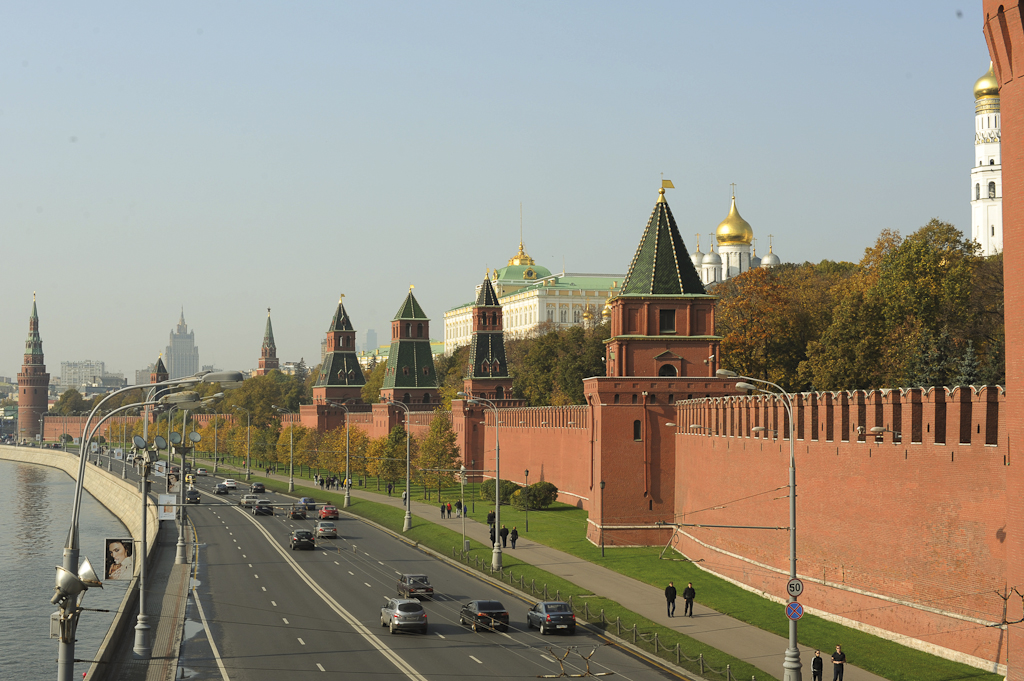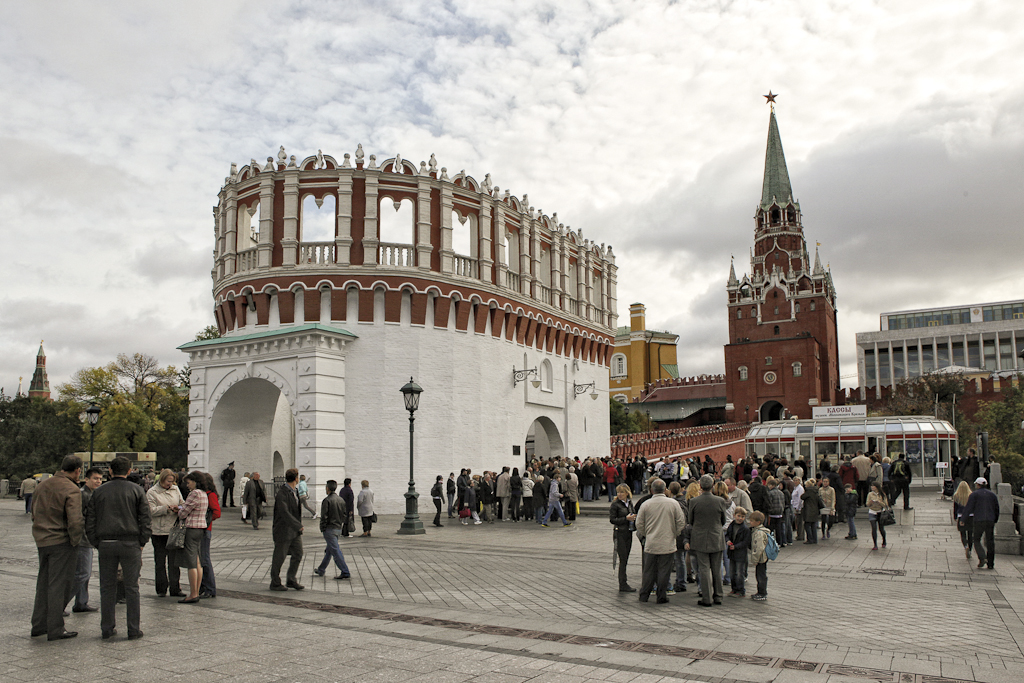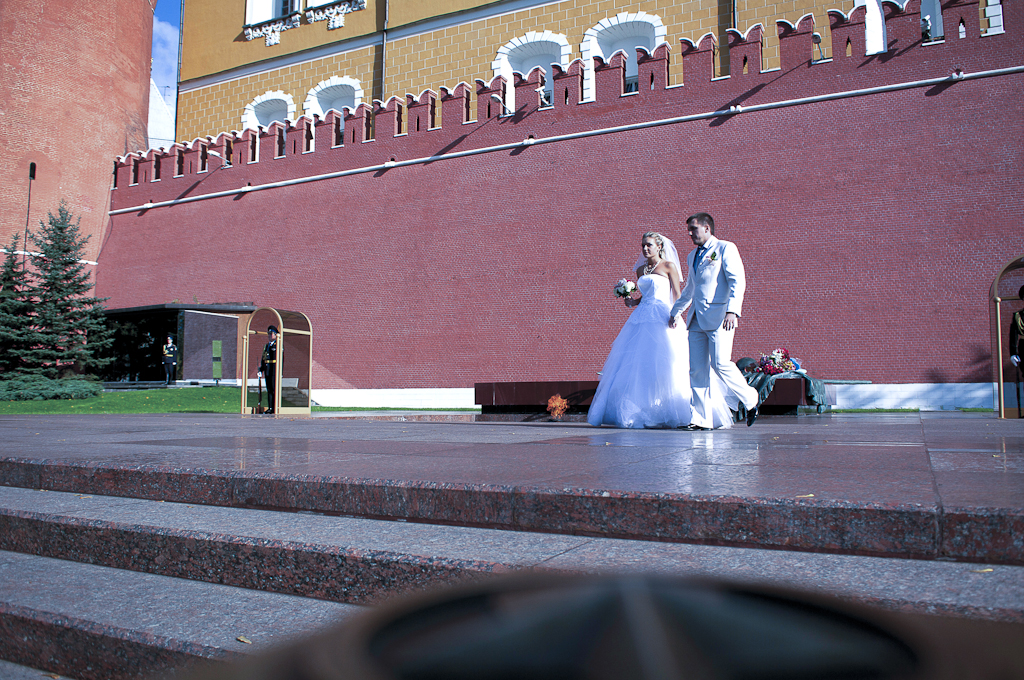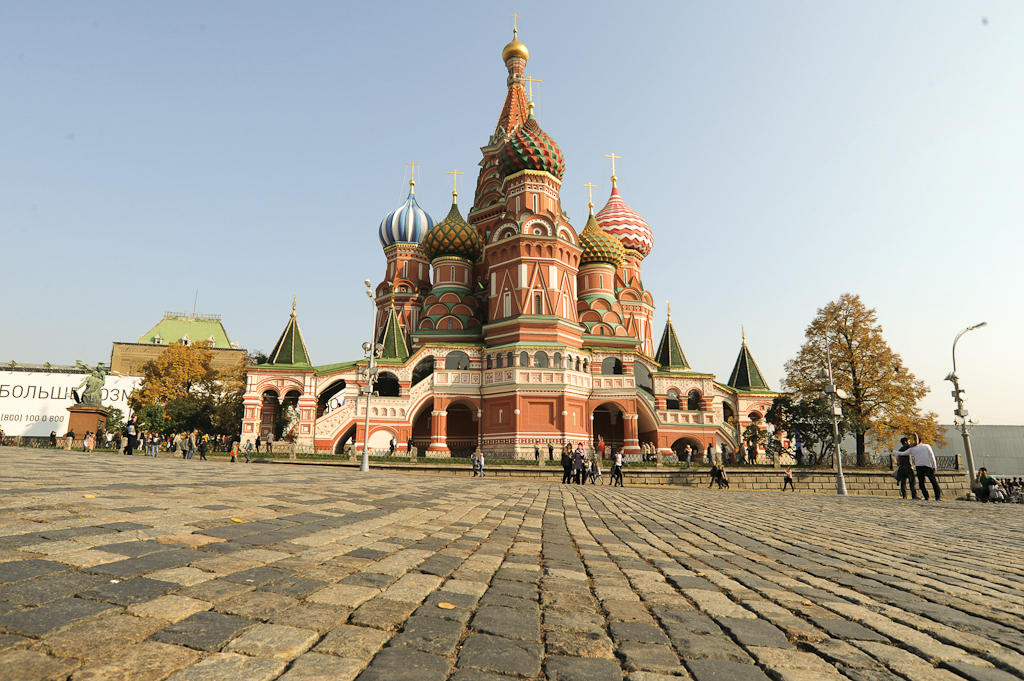In the old times the square was an important element of protection of the Kremlin – this is how Moscow’ s main fortress is called. It was easier to fight enemy in an open space while in the time of peace it was a convenient place for trade. The square was called Veliky Torg (Great Auction) or Pozhar (Fire). In the old Russian language the word “ red” meant “ beautiful” or “ main”. Until now Red Square has remained as the main and the most beautiful square in the city of Moscow.
A monument to K. Minin and D. Pozharsky that is located right in front of St. Basil’ s Cathedral depicts two heroes who liberated Moscow from Polish invaders. Built on public donations in 1818, it is the oldest sculptural monument to be unveiled in Moscow. Its original place was next to the Upper Trade Rows, however, it was moved to its today’ s location in the 1930s to allow military weaponry parades.

To your right is the oldest tower of the Moscow Kremlin called the Savior Tower. Altogether 20 towers stand along the Kremlin wall. The existing walls and towers were constructed in 1485 – 1495. The overall length of the walls is 2,235 meters, their height is from 5 to 20 meters with the width ranging between 3.5 to 6.5 meters. The walls are decorated with 1,045 battlements of the swallow tail shape.
The Spasskaya (Savior) Tower was erected in 1491 by an Italian architect Pietro Antonio Solari, the builder of the Kremlin’ s Palace of Facets. Initially, it was named the Frolovskaya Tower. Later, the tower was crowned with a tall hipped roof and the icon of Spas Nerukotvorny (Devine Savior) was placed above the gate, which had given the name to the tower. It was then that an English clockmaker Christopher Galloway installed a one-handed clock on the tower. The single hand stood still while the clock-face was rotating. In the course of time the tower clock was replaced several times. The present day clock is over a hundred years of age. It is really huge: the hour-hand alone is 3 meters long.

Take a walk downhill along Vassilyevsky Spusk (St. Basil’ s Descent) towards the Moskva River embankment. In the 1930s a city quarter located here was removed to open access to new Moskvoretsky (Moskva River) Bridge.
Turn to the right into the Kremlyovskaya (Kremlin) Embankment. The fifth tower on your way is the Taynitskaya Tower. The year of 1485 when the foundation stone of this tower was laid is considered to mark the commencement of the Moscow Kremlin’ s renovation. The tower’ s builder Anton Fryazin was the first to use red brick for construction of a fortress. Until 1917 every midday a signaling canon would fire from the barbican. Thus Muscovites could tell time. In 1930 – 1933 the barbican was dismantled, the secret well was backfilled and the entry gate was filled with brick.
You are passing by the Vodovzvodnaya (Water-lifting) Tower. It was here that Christopher Galloway mentioned above built the first water delivery system. The water was pumped from the tower to tzar’ s palaces. Lower down the flow of the river one could find so called “ pant-washing” rafts used by washwomen to do the laundry from the Kremlin. In 1937 a red ruby star was installed of top of the tower.

Ahead of us is Big Stone Bridge. A wooden raft bridge which had been here from times immemorial was replaced with a bridge made of stone in the end of the XVII century. It was the first stone bridge across the Moskva River 170 meters long and 22 meters wide. Being known among other wonders of Moscow alongside the Tzar Canon and the Sukharevskaya Tower, it had given its name to the saying “ More than a stone bridge” meaning that something cost an outrageous amount of money. The present day bridge was constructed in the 1930s with the length of about 500 and the width of 40 meters.
As you turn to the right passing by the Lower Alexandrovsky Garden, you would come to the Borovitskaya Tower. According to the legend, its name was derived from a coniferous forest (bor) that grew on the Kremlin hill.
To the left you can clearly see one of the most beautiful buildings in Moscow – famous Pashkov House. It was erected in the 1780s for captain-lieutenant P. Pashkov, the son of Peter the Great’ s batman. The building was allegedly designed by a prominent Russian architect Vassily Bazhenov.
The edifice tops the steep Vagankovsky Hill. The grand entrance to the manor premises are from the bystreet on the opposite side of the main faсade. In times of old a vast garden was planted in front of the building on the slope of the hill with fountains playing along the fencing. For the past one hundred and fifty years Pashkov House has accommodated a library formerly called Rumyantsevskaya. Its present-day name is the Russian State Library – the country’ s largest collection of printed matter.

Meanwhile, you walk down towards the Middle Alexandrovsky Garden. The garden was planted here in the place of the Neglinka riverbed put in a tube in the beginning of the 1820s. Ahead of you is Trinity Bridge which leads the way inside the Kremlin. Erected in 1516, the bridge was reconstructed time and again. In old days it spanned the Neglinka River, at present the alley of the Alexandrovsky Garden lies underneath it. Both ends of the bridge are marked by towers – the Trinity and the Kutafya. The Trinity Tower is the tallest one of all the Moscow Kremlin towers with the height of 79.3 meters. The name of the other tower – Kutafya – must have been derived from an old-Russian word “ kutafya” meaning a clumsy woman. The ticket offices of the Moscow Kremlin are located nearby.
The Upper Alexandrovsky Garden starts right after Trinity Bridge. This part of the garden accommodates the memorial of military glory with the Tomb of the Unknown Soldier and Eternal Flame. Lining the walkway are dark red porphyry blocks with encapsulated soils of the hero cities. It is here by the Tomb of the Unknown Soldier that Post No. 1 of the Guard of Honor of the Kremlin Regiment is to be found. Changing of the Guard Ceremony takes place every hour.

From the Alexandrovsky Garden you can clearly see the beautiful edifice of the Manege. It was built in 1817 by a Spanish architect Agustin de Betancourt on the order of the emperor Alexander I to commemorate the fifth anniversary of the victory over Napoleon. Contemporaries were astonished with the Manege’ s internal design. The roof spanned a huge space without a single internal support. The structure was used first for military parades but as of 1831 various exhibitions, ballroom parties and sports competitions had been held here. The present-day Manege is an exhibition hall.
In front of the Manege is Manege Square. It appeared here no so long ago. Before the 1930s there was a city district in the place of the square with shops, hotels and apartment houses. The present day Manege Square accommodates an underground trade centre with shops and numerous cafes offering a good opportunity for snack and rest.

Alongside the trade centre runs an artificial riverbed imitating the watercourse of the tubed Neglinka with numbers of fountains and sculptures depicting characters of Russian fairy tales.
So, here we are back at the Historical Museum. Don’ t forget to take a careful look at the fence and the grating of the main entrance to the Alexandrovsky Garden. To your left towers the colossus of the Hotel Moskva.
Under the building of the hotel you can find the Moscow Archeology Museum. It displays piers of Voskresensky (Resurrection) Bridge built across the Neglinka River in the XVI – XVII centuries as well as old buried treasures, household utensils including a three hundred year old child’ s boot and a… torn sock. Children are fond of such exhibits. All the objects on display in the museum were found during the excavation in the center of Moscow. On weekends children can take part in various quiz games and contests organized at the museum.
You are back at the Okhotny Ryad Metro Station. This is where we started our walking tour and this is where it may be finished.
